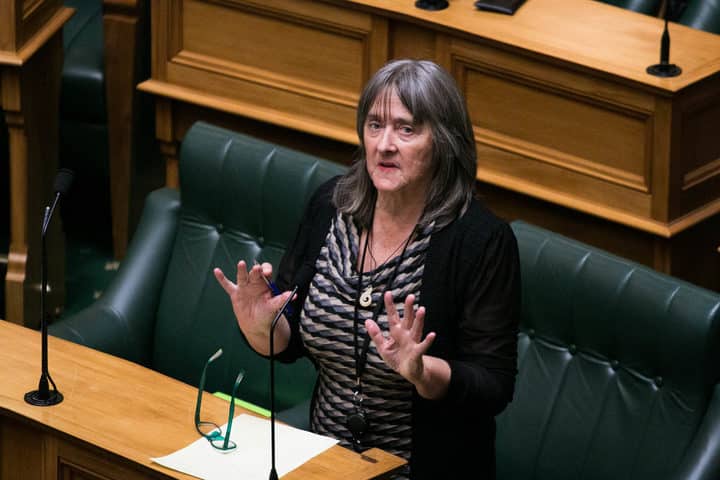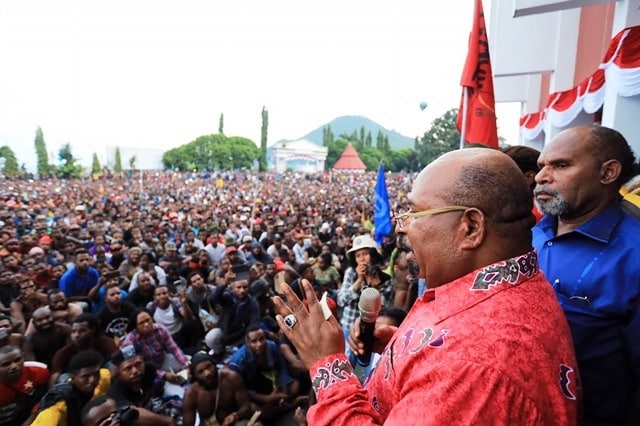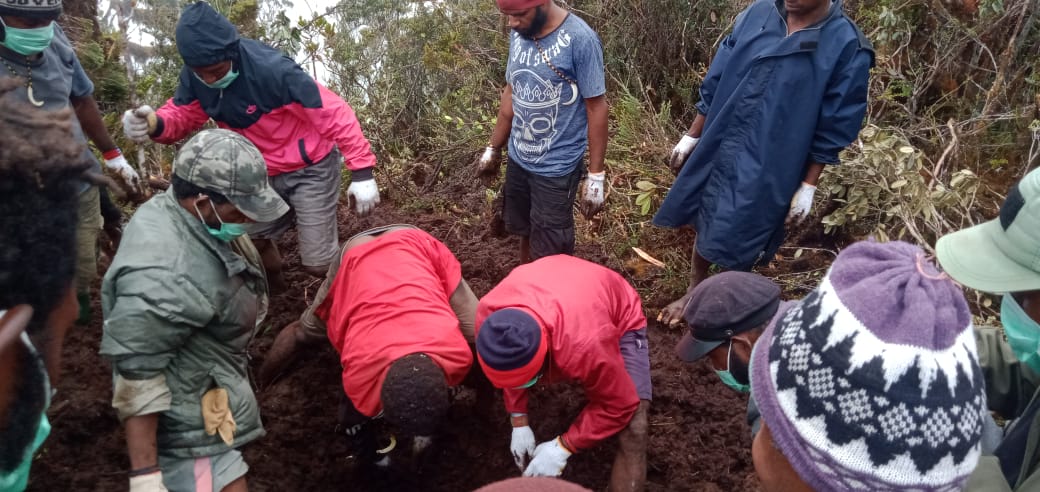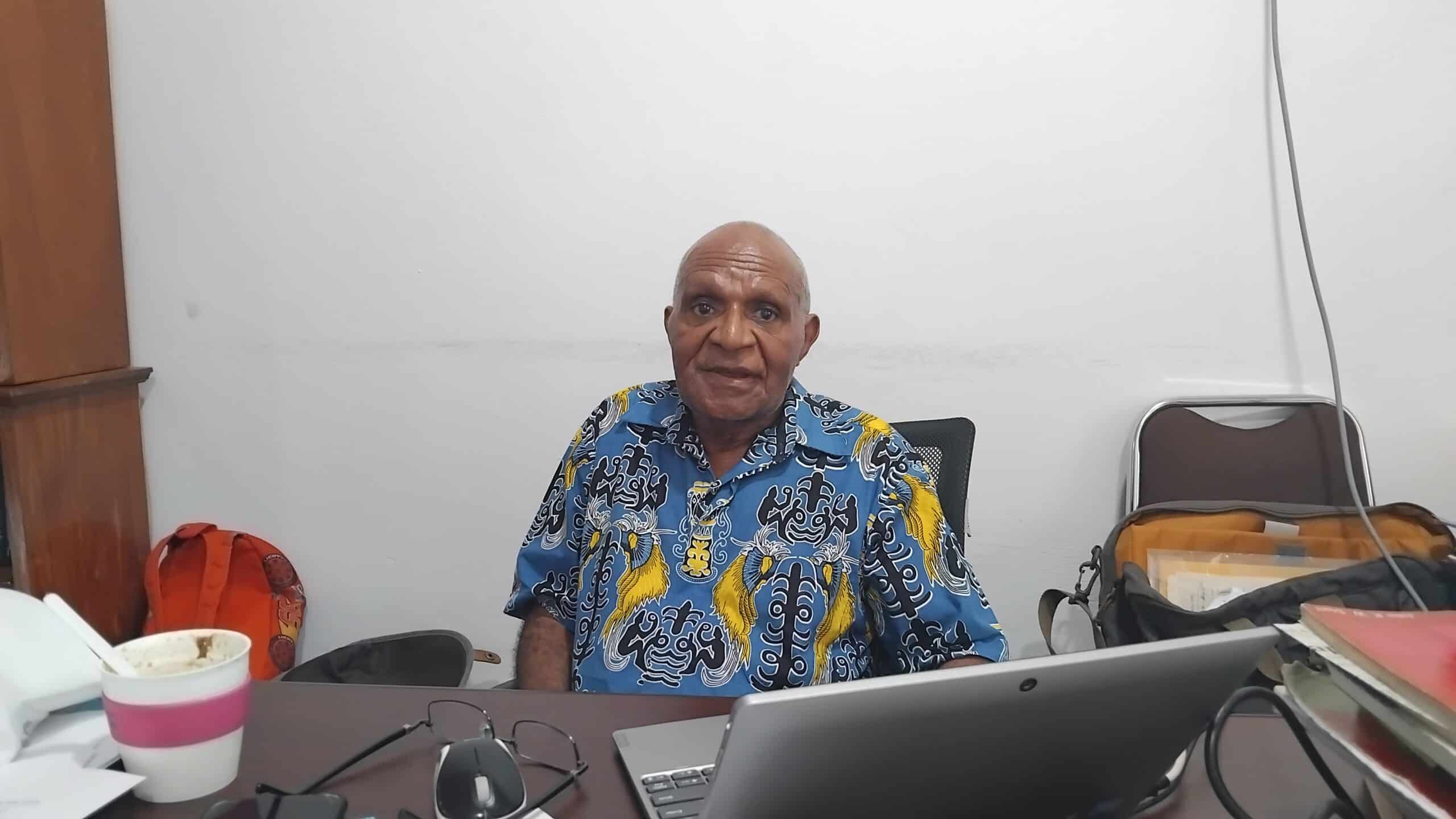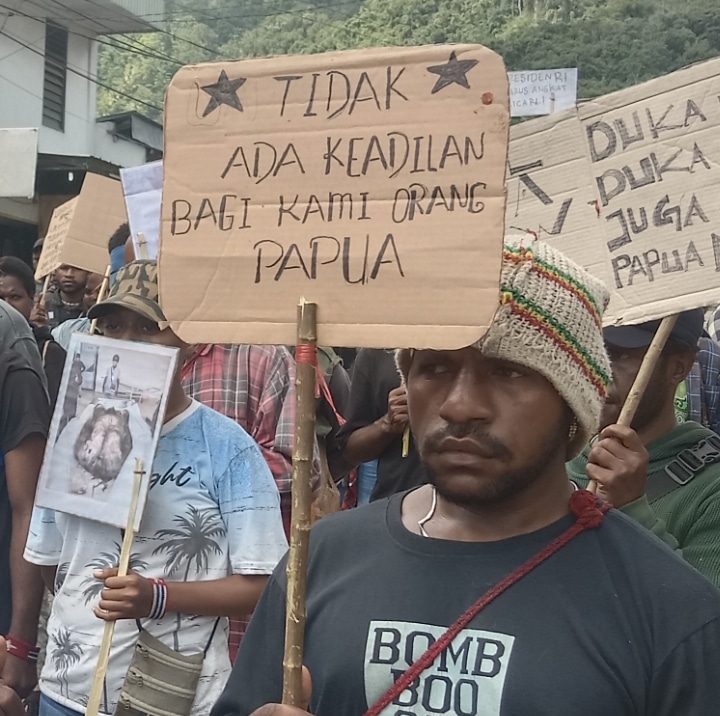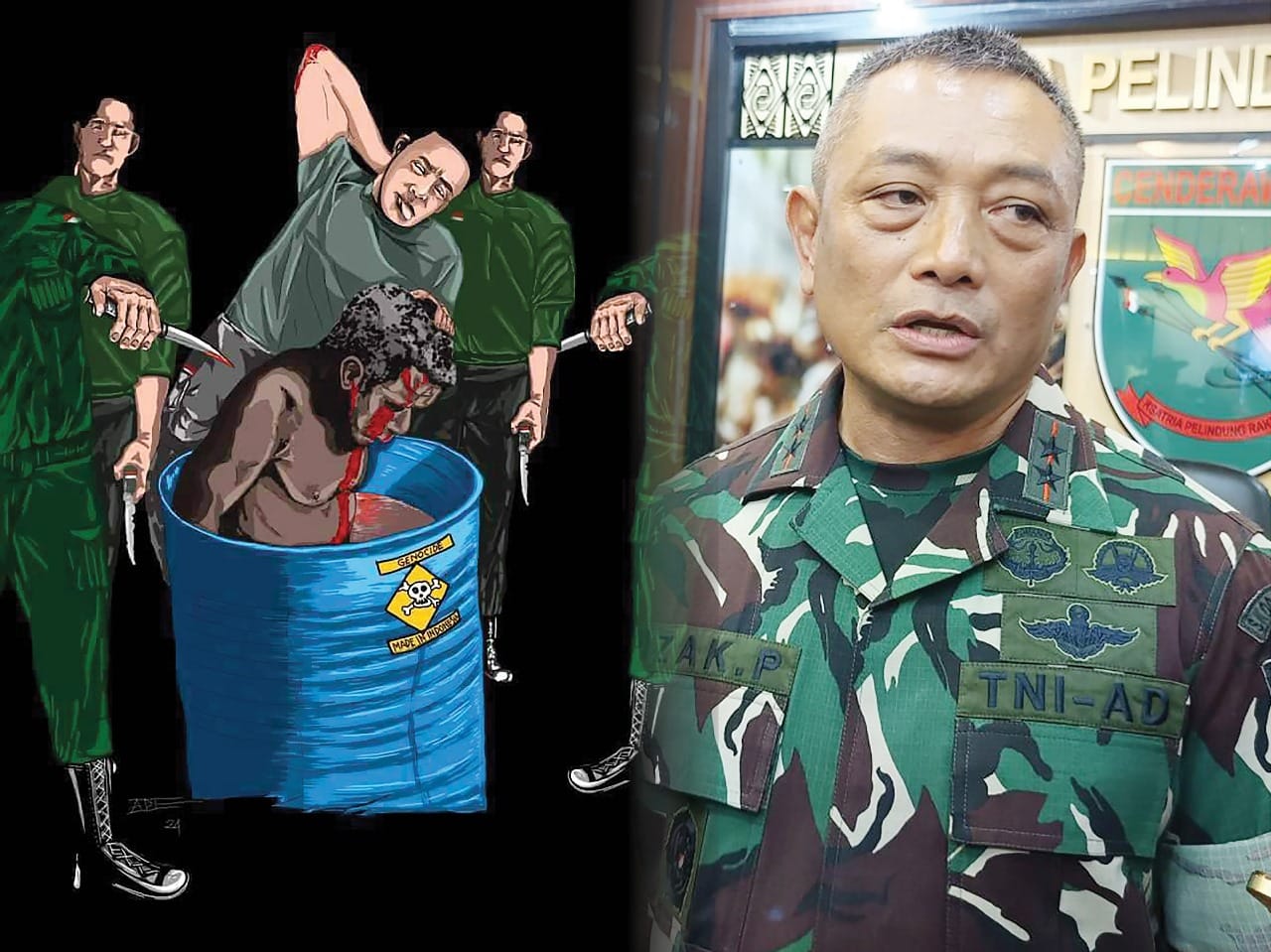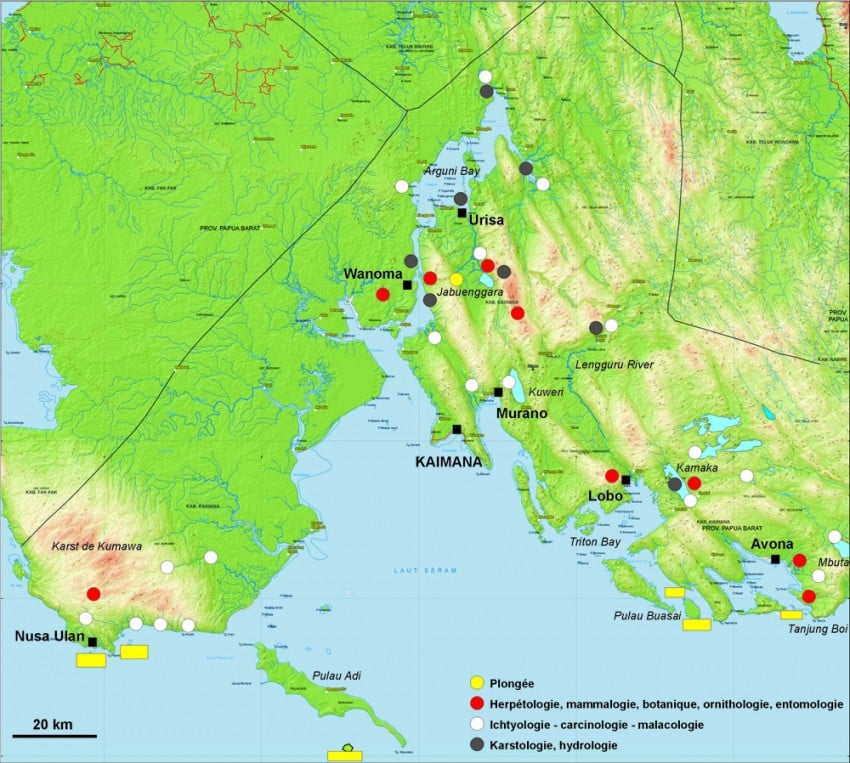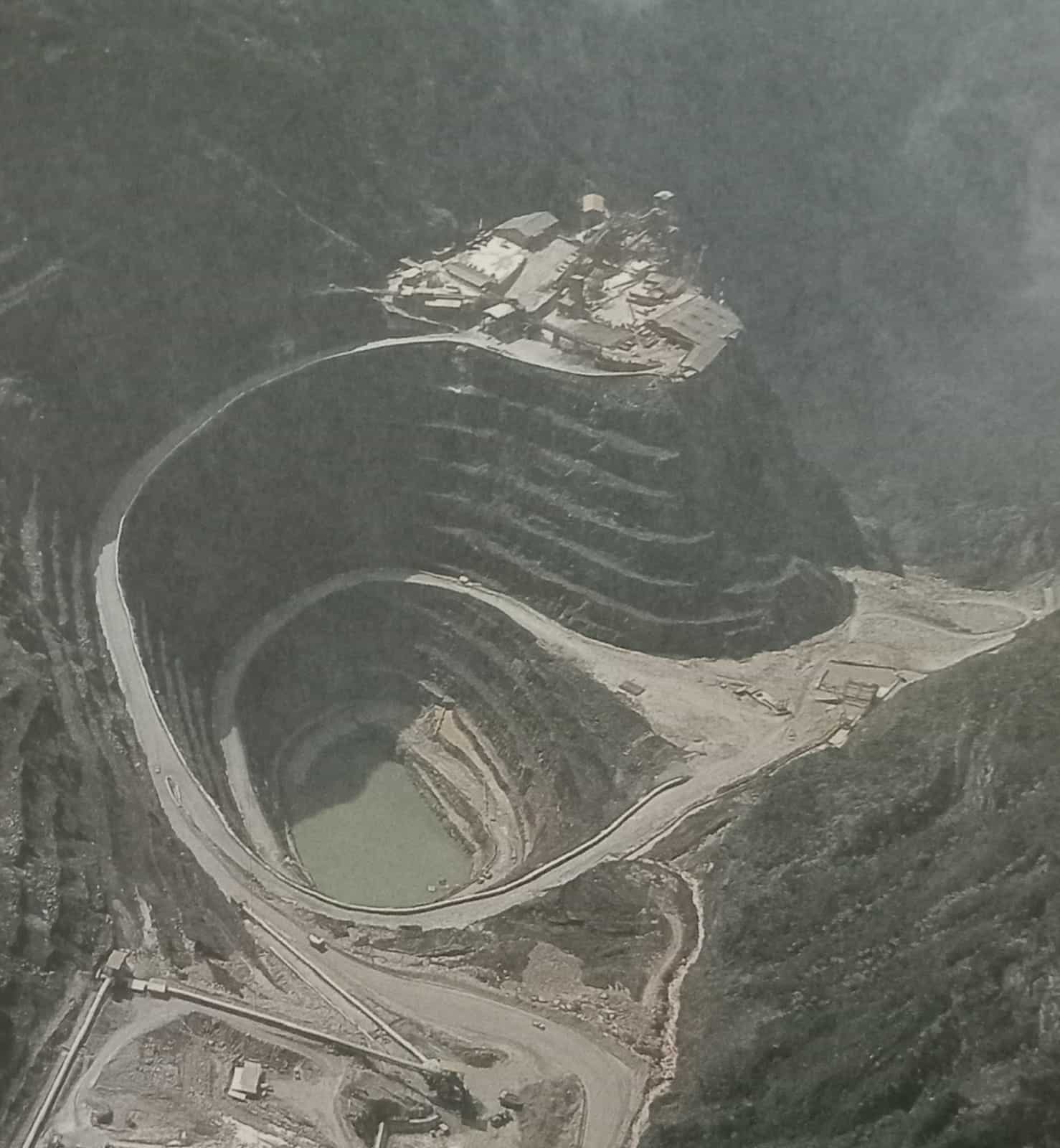The Asia-Pacific Journal, Vol. 13, Issue. 45, No. 1, November 23, 2015
By Camellia Webb-Gannon
Introduction

This article argues that the democratic ideals espoused by Australia and Indonesia fall short in application to West Papua and West Papuans, and notes that such shortcomings are legitimated by mainstream media’s exoticist portrayals of West Papuans, particularly in Australia. The antidemocratic policies and processes of each government with regard to West Papua actually enable the (by and large) “good” bilateral relations at the state level to remain intact. However, this article contends that democracy, as practiced by civil society actors at the grassroots and digital network level in Australia and West Papua, creates cracks in the official Australia-Indonesia state relationship. Australian concerns over Indonesian human rights abuses in West Papua have traditionally been overlooked at the state level in favor of pursuing an amicable bilateral relationship.
However by forging digital activist networks locally and internationally—including building West Papuan-indigenous Australian partnerships, West Papuans are participating in a grassroots democratization process with global outreach, refusing to be sacrificed on the altar of regional realpolitik. The article concludes with a cautionary account of an apparent attempt by an opportunistic Australian political movement to hijack West Papuan democratization for its own ends, a threat West Papuan and Australian civil society activists are currently moving to contain.
West Papuans: cannibals or the sacrificed?
Who isn’t fascinated by a cannibal story – particularly one about a cannibal act purportedly planned in the past decade? In 2006, a weekly current affairs television show hosted by a popular Australian network aired a program introducing Wawa, a then six-year old boy its television crew met during a so-called first contact
encounter with West Papua’s Korowai people. Wawa, the program alleged, was facing imminent cannibalization by his tribe for suspicion of witchcraft. A media fiasco followed in which the television network and its main rival raced to produce a “rescue Wawa” story. The rival’s controversial presenter was deported from West Papua for using a tourist visa, and Wawa was eventually taken from his home by the original network’s Sumatran tour guide to live in Jayapura and, later, Sumatra.
Earlier this year, a staffer of the first-mentioned current affairs program informed me that a follow up story on Wawa and the Korowai was being considered. The plan was to take Wawa on a return visit to Korowai land, ask him to compare his new school and city life with that of his village of origin, and assess how Korowai ways of life, including the practice of cannibalism, had changed since 2006.
This program concept illustrates the entrenched ignorance that pervades the mainstream Australian imaginary of West Papua and other parts of Melanesia. Anthropologist Rupert Stasch, the world’s preeminent scholar on the social relations of the Korowai, visited Wawa’s people after the media maelstrom and, through conversation with those who knew Wawa, found out that “there was a predictably wide gulf between the representations that had circulated in the international media and the boy’s actual history as understood by his kin and co-villagers (who were unaware of the media coverage) (1)”. Further, “almost all persons [Stasch] spoke with said that the exclusive reason the first film crew’s guide had been approached by villagers about taking the orphan to town was so that he would go to school, become literate in Indonesian, and return as a teacher, nurse, or government official. These numerous persons matter-of-factly denied […] suggestions that the boy had been rumored to be a witch, or had been in danger of being killed” (2).
“First contact” tourism and journalism are sensationalist, essentialist and, with regard to the Korowai, misleading – European missionaries have lived with the Korowai since the 1970s and the Korowai are knowing, if far from equal, agents in the marketing of their “culture” to outsiders. The removal of children from their families of origin by Western journalists chasing television ratings is of course ethically highly dubious. Yet, despite the informed criticism directed towards the current affairs program after its 2006 West Papua foray, it has contemplated revisiting the Wawa story. West Papua has, for a long time, threatened the stability of the Australia-Indonesia relationship but Australian citizens have pressured their government not to let the Indonesian government escape criticism for the crimes its military forces commit in West Papua. In portraying West Papuans as less than civilized, mainstream Australian media fabrications such as the “Wawa story” serve to uphold Indonesia’s ongoing colonial occupation of West Papua.

They also support an Australian media-military complex—providing a veneer of justification for Australian training of Indonesian security forces (3),—which in turn “keeps in check” the “violent” peoples of “Stone Age” Papua. Such portrayals (4) feed into one of two broad narratives that surround military and government bilateral relations between Australia and Indonesia in which West Papua is treated by Australia as either a pawn or a liability. In the first narrative, that of “primitive and unpredictable Papuans”, the Australian public gaze is momentarily averted from the violence of the Indonesian military in West Papua, and the pressure on the Australian government to hold Indonesia accountable is relieved. The second narrative will be dealt with in the remainder of this article.
***
This second narrative presents Indonesia as a “normal”(5) country – that is, democratizing, not subject to military excesses, and accountable to the rule of law. The Indonesian government frequently asserts that these apparent attributes also extend to its rule in West Papua. Yet, upon examination, they appear to be observed more in the breach than otherwise. The Australian government’s willingness to pay lip service to Indonesian claims, for the sake of harmonious relations with Jakarta, silences West Papuans’ grievances at the official, bilateral level.
The Australia-Indonesia relationship itself is often portrayed as one incrementally strengthening due to Indonesia’s supposedly increasing democratization. What is rarely considered, however, is the extent to which Australian democratic principles are applied to, and what relationship the democratic credentials of either government has with, the political plight of West Papuans. Each of these concerns has important implications for the civil societies and governments of both countries, as well as their bilateral relationship. Indeed, it appears that it is mutual complicity in the antidemocratic processes being enacted in Indonesia and Australia with regard to West Papua that tends to strengthen the bilateral relationship at the state level. Simultaneously, that “good” relationship is threatened by the alternative processes of digital networking and grassroots democratization which ignore state borders and bring civil society in Australia and West Papua closer together.
For example, much has been made of Indonesia’s democratization since the fall of Suharto in May 1998, and the implementation of electoral reforms from 1999 onward. However, democratic reforms have had a limited reach in West Papua. For example, in 2003, the province of Papua was divided into two, “Papua” and “West Papua”, by the central government, contrary to local wishes and national law. Local Papuan political parties are banned (6). The Freeport mine, controlled by an American company that pays huge royalties and taxes to Jakarta, exploits West Papuan natural resources, wreaks havoc on the environment and local communities, yet yields negligible benefits to Papuan people (7).

And the Indonesia military operates with near impunity in West Papua. In December 2014, four unarmed West Papuan youth were killed and 17 more injured in Paniai when the Indonesian army and police opened fire on a group of protesters. Although an investigation into this massacre was opened, it has been compromised by police involvement. Military and police violence has also been a mainstay around Freeport’s mines in Timika since the company began operations in the 1970s as security forces vied with each other for lucrative “protection” contracts for the company. There is strong evidence suggesting that security forces also orchestrate violent conflict around the mine (for example, ambushes along the road leading to the mine) and then blame such violence on the guerilla-led Free West Papua movement, legitimating their own presence in the process (8).
High hopes were held for democratic improvements in West Papua when Joko Widodo became Indonesia’s president in 2014. In his most recent visit to the region, Widodo released five political prisoners and announced that the ban on foreign journalists visiting West Papua would be lifted. However West Papuan activists claim that the release of the five prisoners, who were required to ask for clemency, was tokenistic since some 500 more protesters were subsequently arrested in May and June this year (9). Papua observers in Indonesia, such as Andreas Harsono of Human Rights Watch, also doubt the President’s power to carry out a dramatic reversal to the longstanding international media blackout on West Papua kept in place by 18 central government agencies whose permission is required to visit the territory and who profit from their visa vetting role (10). Scholar of Papua, Budi Hernawan, observes that Widodo is rapidly losing credibility within his own government.

The military is agitating for a presidential decree to mandate control of public order by the army and for an amendment to the law that requires such a decree in the first place (11). In other words, according to Hernawan, the army is working towards bypassing Presidential checks and balances in order to once more practice, unfettered, the fomentation of conflict that justifies its existence in the far reaches of Indonesia—particularly West Papua (12).
Australian democracy and West Papua
In recent years, as democratic processes have been rolled out in other parts of Indonesia, the Australian government has legitimated the charade that those same processes are reaching West Papua. In fact, Australia has maintained a “pragmatic complicity”(13) in Indonesia’s treatment of West Papua since Indonesia invaded the territory in 1962 (shortly after West Papua’s previous colonizers, the Dutch East Indies, had made preparations with West Papuans for an independent West Papua), and has done little to protest the litany of human rights crimes committed by the regime. These include widespread instances of torture and rape of West Papuans, forced removal from traditional lands, environmental devastation, curtailment of civil and political rights, starvation, assassinations and disappearances (14). Such concerted violence has stemmed from Indonesian expansionist and resource exploitation endeavors in West Papua, attempts to eradicate West Papua’s independence movement (formed in protest to Indonesian occupation and fuelled by ongoing Indonesian violence), and longstanding racism against West Papuan people.
In 1962, when West Papua’s future political status was under negotiation, Australia’s external affairs minister Garfield Barwick asserted that it was not in Australia’s strategic interest to counter Indonesia’s expansionary designs on West Papua; Australia would be better served forging diplomatic ties with a non-communist Indonesia (15). The Australian government therefore supported the US-brokered 1962 New York Agreement that bequeathed the territory to Jakarta, and the subsequent rigged 1969 Act of Free Choice that formalized West Papua’s ongoing annexation by Indonesia.
Despite the fact that West Papua’s status as part of Indonesia has been contested ever since, Canberra’s position has been unwavering. As recently as 2006 Australia and Indonesia negotiated the Lombok Treaty which contained a “Papua Clause” committing the Australian government to “not in any manner support or participate in activities by any person or entity which constitutes a threat to the stability, sovereignty or territorial integrity of the other Party, including by those who seek to use its territory for encouraging or committing such activities, including separatism, in the territory of the other Party” (16). Signing this agreement signalled the Australian government’s willingness to curtail the democratic freedom of its own citizens to support persons involved in West Papua’s independence struggle; this, in order to assure Indonesia of its unconditional recognition of Indonesian sovereignty over West Papua.

When Mako Tabuni, a West Papuan independence activist, was murdered in the street in Jayapura in 2012, eyewitnesses and, later, Australian investigative journalists, asserted that the murder was committed by the partly Australian funded and trained Indonesian anti-terror police squad, Detachment 88 (17). The following year three West Papuan men climbed the walls of the Australian consulate in Bali immediately prior to an anticipated visit by Australian Prime Minister Tony Abbott, seeking refuge and calling for the release of political prisoners in West Papua. Australian academic Clinton Fernandes, who was on the telephone to the consulate at the time of the incident, overheard an Australian voice threatening to bring in the Indonesian military and police to remove the Papuan men. The latter were forced to flee the consulate, fearful for their lives (18).
In the aftermath of this incident Abbott stated his desire to convey “in flashing neon lights” that attempts to “grandstand” against Indonesia by involving Australia were “not welcome”. Asserting, as Australian leaders regularly do, that Australia respected Indonesia’s territorial integrity and sovereignty, Abbott added, following the lead of Indonesian leaders, that “the situation in West Papua was ‘getting better, not worse’”(19).
The combined efforts of the Indonesian and Australian governments to whitewash ongoing brutalities in West Papua are under constant pressure, however. Moreover, since most Australian statements regarding relations with Indonesia are prefaced with references to the Australian national interest, Indonesia knows Australian policy on West Papua is strategically and, at times, legally contingent. Indeed, precedents exist for Australian support of human rights and self-determination in contested Indonesian territories. In addition to Australia’s about face from support for Indonesian sovereignty in East Timor in 1999 to rejecting it, Australia also recognized 43 West Papuans who arrived in Australia in 2006 as legitimate asylum seekers and granted them temporary protection visas, prompting Jakarta to recall its ambassador from Canberra in protest.
There have been other hints that Canberra’s continued acquiescence over West Papua has its limits. After allegations emerged in 2013 that Australia had been spying on Indonesian officials, and Indonesia responded by threatening to cease cooperation on managing “people smuggling”, Abbott reminded Jakarta that Australia had attempted to dissuade Australian-based West Papuan activists from traveling by boat to West Papua, effectively implying that Australian support for Indonesian sovereignty over West Papua was tied to cooperation from Indonesia on issues of Australian national concern (20).
All of this demonstrates that, at a state level, both Australia and Indonesia are willing to exaggerate the bona fides of Indonesian democracy in West Papua and collude to cover up direct violations of democracy and human rights in the territory. As a result neither country is acting altruistically with regard to West Papua. Indonesia is vested financially in occupying West Papua, and Australia is vested financially in appeasing Indonesia and thus condoning its occupation of West Papua (21). Nevertheless, there is hope that significant shifts in Australia’s approach to West Papua might be possible. At present though, it appears that the strength of Australia-Indonesia ties in relation to West Papua is in inverse proportion to the degree of democracy and human rights respect afforded West Papuans and their Australian supporters.
Grassroots democracy and digital networks
By contrast, transformative democratization, in essence coordinated purposeful action by and for the affected people, is occurring at grassroots activist and digital network levels, linking West Papuan, other Melanesian, and Australian civil society communities in solidarity against state-centric oppressive concepts of sovereignty. This is expressed in a burgeoning genre of West Papua independence music being created by West Papuans and their Melanesian and Australian supporters and distributed digitally via YouTube, Soundcloud, iTunes, Bluetooth and SD cards through ever expanding digital networks (22). While evidently the digital revolution has not impacted all populations equally, it has had the effect of spreading music, foundational to Melanesian cosmology and the life force of West Papua’s independence movement (23) widely and lifting the regional profile of the West Papuan struggle. Moreover, social media has also elevated the perceived urgency of the struggle in mainstream Australia and internationally, propelling the circulation of mobile phone videos such as those depicting the torture of West Papuans (24), and attracting the intervention of internet activist hacker group Anonymous on behalf of West Papuans (25).
A grass roots activist movement—recognizing a shared history between indigenous Papuans and indigenous Australians of settler colonial violence and cohabitation of the prehistoric continent Sahul (a Pleistocene era landmass that included mainland Australia, Tasmania, New Guinea, Seram and possibly the island of Timor)—has emerged over the past two years, most dynamically in the initiative of the West Papua Freedom Flotilla (26). This project has involved two maritime missions, with West Papuan and Aboriginal activists using Aboriginal “passports” and West Papuan “visas” in an effort to carry water from Lake Eyre to West Papua—a form of nonviolent direct action highlighting West Papua’s violent occupation and symbolizing Oceanic indigenous articulations.
Two other events are notable with regard to West Papuan-oriented activism in Australia. In April 2014 an office opened in Perth to carry out the work of Oxford-based West Papuan refugee and independence activist Benny Wenda and his Free West Papua campaign (27). Soon after, in June 2014, the author attended the opening of the Federal Republic of West Papua’s Department of Foreign Affairs Immigration and Trade office headed up by Foreign Minister, Jacob Rumbiak, a former West Papuan political prisoner living in exile in Melbourne. The office was located in an architecturally slick, eco-friendly complex in Melbourne’s central business district and its opening was officiated by various local government officials, indigenous Australian leaders, and a university representative. Both of these offices were established in contravention of the Lombok Treaty and remain in operation, demonstrating that grassroots, people-led movements can thrive in the interstices of top down, anti-democratic power.
Supporters of the West Papuan rights movement in Australia include artists, academics, people of faith, lawyers and environmental and indigenous rights activists who are often loosely aligned with the several city-based Australia West Papua Associations and who work in tandem through these networks.

In July 2013, the West Papua Project at The University of Sydney produced a citizens tribunal, the first of its kind in Australia, weighing evidence and hearing testimonies from survivors of the 1998 Biak Massacre in which Indonesian security forces murdered up to 200 West Papuans peacefully demonstrating on the West Papuan island of Biak (28).
The Indonesian military has never been held accountable for this massacre, and notable Australian legal personalities, concerned academics from institutions across Australia, and other activists cooperated in an effort to bring a degree of justice and closure to the victims even in the absence of a legal remedy. In March 2015, several of the tribunal team led by Justice John Dowd and academic Eben Kirksey presented the evidence brief to Liberal, Labor and Greens party politicians in federal parliament and met with a favorable tripartisan reception, further evidence that small initiatives can reach the halls of power, if not yet the decision-making chambers.
Australian academics—some of whom are affiliated with the West Papua Project at The University of Sydney—have also been involved with West Papuan efforts to make their political presence known in the Melanesian region, assisting the United Liberation Movement for West Papua (ULMWP) to develop its latest submission for membership to the Melanesian Spearhead Group (MSG). The MSG, a political bloc comprised of the four Melanesian countries – Papua New Guinea, Vanuatu, the Solomon Islands, and Fiji—was formed in 1986, in part to lobby France for New Caledonian independence. As such, the indigenous Kanak independence party, the Kanak and Socialist National Liberation Front (French: Front de Libération Nationale Kanak et Socialiste, FLNKS), has been an integral member of the MSG from its inception.

And West Papua has for several years sought membership on the same basis. A limited victory was celebrated in June 2015 by West Papuans and their supporters when West Papua was granted observer status in the MSG, although at the same meeting Indonesia was granted associate membership, a higher level, which somewhat dampened West Papuans’ celebrations.
These community-initiated activities of West Papuans in Australia, and of Australians working in solidarity with them, demonstrate that steps toward positive change in West Papua are being pushed from the bottom up rather than the top down. These actions in Australia and West Papua suggest possibilities for a brighter, more democratic future for West Papuans, in spite of Indonesian and Australian government efforts to stymie them.
Reclaim Australia and the Free West Papua Party
(29), which appears to be capitalizing on the Free West Papua Campaign “brand” created by dynamic West Papuan activist Benny Wenda. The party combines anti-Islamic ideology and unrealistic goals, (30) claiming to possess “the potential to quickly free West Papua through the next Federal Election” (31). In July 2015 its leader delivered a speech at an ultra-nationalist Reclaim Australia rally purporting to support West Papuan freedom in an era of Islamization. Campaigning for West Papua at such events conveys the impression that the fight for the independence of West Papua is primarily religious (i.e. a Christian versus Muslim struggle), which it is not, although at times it does assume a religio-cultural tone. In fact, many West Papuans, including some independence leaders, are Muslim (32). Both Australian supporters of West Papuan rights and West Papuans residing in Australia have moved quickly to distance themselves from the Free West Papua Party and its ideological tenets and implications (33).
Further, indigenous Australians are protesting against the Reclaim Australia movement (34). If what Reclaim Australia supporters are really trying to do is “reclaim” Australia for a majority “caucasian [sic] and Christian” (35) population (and those with “assimilationist” aspirations), then it hardly seems appropriate for an Australian political party to drag indigenous West Papuans into the movement. Finally, as previously mentioned, indigenous West Papuans and indigenous Australians are already working together in a dynamic movement to recognise indigenous sovereignty in their respective lands with the Freedom Flotilla initiative. This is an internally organized, organic movement that represents a positive reclamation and an indication, among others (for example the progress made within the MSG, the tabling of West Papuan grievances at the Pacific Islands Forum (36), and the rise of Pacific-wide solidarity for West Papua (37)) that the West Papuan independence movement is garnering increasing international awareness.
Yet despite this forward momentum, West Papua is in the grip of a serious demographic crisis. A history of Indonesian state-sponsored transmigration and continuous, rapid and spontaneous migration from other parts of Indonesia to West Papua, coupled with high mortality and morbidity rates for West Papuans compared with non-Papuans (38) has meant that indigenous West Papuans, since 2010, have become a demographic and cultural minority in their homeland (39). Even though many West Papuans campaign for a referendum on independence, in statistical terms, if this becomes an option for them as it did for the East Timorese in 1999, it is unlikely to deliver the result hoped for by indigenous independence-seekers. The future is likely to be bloody, as West Papuans have demonstrated since the 1960s that they will not back down, even in the face of military terror, from their pursuit of independence.
When the Suharto-era general and notorious strongman Prabowo Subianto was Widodo’s challenger for the position of Indonesian president leading up to the last election, predictions for the status of West Papuans should his campaign be successful were “apocalyptic” (40). Yet Widodo’s apparent inability to stand up to pressure from military forces lobbying to sit above civilian authority may still have apocalyptic consequences for West Papuans should the military subsequently be given freer reign in West Papua. If the result of increased militarization in West Papua is a showdown like that of East Timor’s 1991 Santa Cruz massacre in which 250 protesters were murdered, international civil society pressure might occasion a multilateral intervention. Although the second of these possible futures is West Papuans’ most immediate hope for independence, both are grim. Their most promising option, and the one in which most efforts are currently being channelled, is the strengthening of grassroots democratic networks and forging of regional solidarity. Time, however, is of the essence. Demographic transition in West Papua is the key challenge.
Conclusion
This article has attempted to demonstrate that it is important that the Australian public not take too narrow a view of Australian national interest – the Australian government has already made that mistake with regard to West Papua. Indeed, the Australian government should remember that what it considers to be in its best interest can change dramatically and rather suddenly, as its 1999 intervention into East Timor revealed. The Australian public would do well to follow the lead of indigenous West Papuans and indigenous Australians in lobbying the Australian government and demonstrating to mainstream media that democracy in Indonesia and in Australia should not be solely for the benefit of privileged ethnicities and the already rich. Rather, democracy ought to encompass politico-legal ethics and processes that facilitate the meaningful self-determination of each society’s most vulnerable groups. A healthy relationship between the two countries—one that valued democracy in each—would acknowledge both in law and in practice the traditional custodians of the various territories comprising the two countries. It would be committed to fostering peaceful explorations of self-determination engaging indigenous peoples as primary actors. It would consider unacceptable the circulation of tired, clichéd and frankly dehumanizing portrayals of West Papuans as cannibals, as subjects for entertainment on Australian television. Given the tragedy of Australia’s own Stolen Generations from indigenous people, further Australian media interventions in the life of Wawa, an already traumatised indigenous child, should certainly be off limits.
Acknowledgements
Comments by Adam Stott, Peter King and Michael Webb helped to improve an earlier version of this manuscript, for which I am most grateful.
Camellia Webb-Gannon is a Research Fellow with the Digital Humanities Research Group at Western Sydney University and is the Coordinator of the West Papua Project at The University of Sydney. Her PhD in Peace and Conflict Studies from The University of Sydney examined the dynamics of unity and conflict within West Papua’s independence movement. Recent research considers the impact of digital technologies and the arts on human rights advocacy as well as local interpretations of Melanesian indigenous rights, Melanesian self-determination movements, and concepts and mechanisms of justice in Oceania.
Recommended citation: Camellia Webb-Gannon, “Salvaging Democracy for West Papuans in the Face of Australia-Indonesia Obstruction”, The Asia-Pacific Journal, Vol. 13, Issue 45, No. 1, November 23, 2015.
Related articles
• Camellia Webb-Gannon and Jim Elmslie, MSG Headache, West Papuan Heartache? Indonesia’s Melanesian Foray
• David Adam Stott, Would An Independent West Papua Be A Failing State?
• David Adam Stott, Indonesian Colonisation, Resource Plunder and West Papuan Grievances
Notes
1 Rupert Stasch, 2014, ‘Powers of Incomprehension: Linguistic Otherness, Translators and Political Structure in New Guinea Tourism Encounters’, Hau Journal of Ethnographic Theory 4:2.
2 Ibid.
3 Hayden Cooper and Lisa Main, 2012, ‘Australia Faces Links to West Papua Torture’, ABC’s 7:30.
4 Other examples (not Australian) of such media portrayals of West Papuans include the following: Carl Hoffman, 2014, Savage Harvest: A Tale of Cannibals, Colonialism and Michael Rockefeller’s Tragic Quest for Primitive Art, Text Publishing; Milt Machlin, 1972, The Search for Michael Rockefeller, Putnam; Robert Norton, 2015, ‘Ambushed: Escaping the Cannibals of West Papua, Indonesia’, Yahoo Travel; and Paul Raffaele, 2006, ‘Sleeping with Cannibals’, Smithsonian Magazine.
5 Andrew MacIntyre and Douglas E Ramage, 2008, ‘Seeing Indonesia as a Normal Country: Implications for Australia’, Australian Strategic Policy Institute.
6 Jason MacLeod, 2010, ‘Papuan Struggle Enters New Phase’, Open Democracy.
This curtailment of political freedom extends into all provinces of Indonesia with the exception of Aceh which alone has been able to successfully lobby (as part of its 2005 peace negotiations with Jakarta) for the formation of its own political parties.
7 Freeport is Indonesia’s largest revenue contributor – in 2014 alone it paid the Indonesian government US$1.5 billion in tax (Nithin Coca, 2015, ‘West Papua: Mining in an Occupation Forgotten by the World’, Equal Times). It operates the world’s largest gold mine and third largest copper mine in Timika, West Papua, and the untold environmental devastation it has wreaked during its tenure in West Papua prompted the Norwegian government, in 2008, to divest AU$1 billion
from Rio Tinto, Freeport’s partner in West Papua (Benny Wenda, October 12, 2011, ‘Everyone profits from West Papua, except for West Papuans’, The Guardian). Papuan miners are paid unconscionable wages, the local peoples – the Amungme and Komoro tribes – have lost ancestral lands of sacred, economic, and social significance, resultant internecine violence abounds, and the military and police wage an ongoing war over ‘security’ contracts for the mine (see Coca and Wenda, this note).
8 For an excellent exposition of the politics of security around Freeport, see Eben Kirksey and Andreas Harsono, 2008, ‘Criminal Collaborations? Antonius Wamang and the Indonesian Military in Timika,’ South East Asia Research 16:2, pp. 165-197.
9 ‘May 2015: While Jokowi Releases Five, Nearly 500 are Arrested’, Papuans Behind Bars.
10 Andreas Harsono, June 12, 2015, ‘Jokowi, Human Rights in Indonesia and Peace in West Papua’, Special Forum hosted by the Centre for Peace and Conflict and the Department of Indonesian Studies at The University of Sydney. See also Coca, above n. 7.
11 Budi Hernawan, November 3, 2015, ‘The Rise of Pacific Solidarity for West Papua,’ Special Forum hosted by the Centre for Peace and Conflict Studies at The University of Sydney.
12 Ibid.
13 Stuart Rollo, 2013, ‘Ending Our Pragmatic Complicity in West Papua’, The Drum.
14 See John Wing and Peter King, 2005, ‘Genocide in West Papua? The Role of the Indonesian State Apparatus and a Current Needs Assessment of the Papuan People’, Centre for Peace and Conflict Studies, The University of Sydney;
Jim Elmslie and Camellia Webb-Gannon, 2013, ‘A Slow-Motion Genocide: Indonesian Rule in West Papua’, Griffith Journal of Law and Human Dignity 1:2, pp. 142-166; Elizabeth Brundige, Winter King, Priyneha Vahali, Stephen Vladeck and Xiang Yuan, 2004, ‘Indonesian Human Rights Abuses in West Papua: Application of the Law of Genocide to the History of Indonesian Rule’, Allard K Lowenstein International Human Rights Clinic Yale Law School.
15 Richard Chauvel, 2012, ‘50 Years On, Australia’s Papua Policy Is Still Failing’, Inside Story.
16 Department of Foreign Affairs and Trade, 2006, ‘Agreement Between the Republic of Indonesia and Australia on the Framework for Security Cooperation (“The Lombok Treaty”)’.
17 Hayden Cooper and Lisa Main, 2012, ‘Australia Faces Links to West Papua Torture’, ABC’s 7:30.
18 Clinton Fernandes, 2013, ‘West Papuans in the Consulate’, Right Now: Human Rights in Australia.
19 Lauren Wilson, October 8, 2013, ‘Abbott Warns West Papuan Activists, The Australian.
20 Michael Bachelard, December 6, 2013, ‘Lines Crossed on Indonesia-Australia Spy Agreement’, The Sydney Morning Herald.
21 As mentioned in note 7, the Indonesian economy relies heavily on revenue raised through Freeport’s mines in West Papua. In 2013, Australia’s two-way trade with Indonesia amounted to nearly $3.7 billion, and its investment in Indonesia was “$10.9 billion, up from $6.2 billion in 2012. Indonesian investment in Australia was around $959 million in 2013” (Australian Government Department of Foreign Affairs and Trade, n.d., ‘Indonesia Country Brief’).
22 Many of these songs have been collated on the author’s YouTube channel.
23 Julian Smythe, 2013, ‘The Living Symbol of Song in West Papua: A Soul Force To Be Reckoned With’ Indonesia 95.
24 Asian Human Rights Commission, 2010, ‘The Indonesian Military Ill-treat and Torture Indigenous Papuans’.
25 Papua Merdeka, 2014, ‘Anonymous Message to the Indonesian Government About West Papua Genocide’, YouTube.
26 See the Freedom Flotilla website.
27 Free West Papua Campaign, April 25, 2014, ‘Free West Papua Campaign to Open New Office in Perth, Australia’, Free West Papua Campaign.
28 See the Biak Massacre Citizens Tribunal website.
29 Free West Papua Perth Australia, May 6, 2015, ‘Membership for Free West Papua Party’.
30 Suresh Rajan, July 21, 2015, ‘“There Are Many Causes I Would Die For. There Is Not A Single Cause I Would Kill For”. Mahatma Gandhi”, The Stringer, http://thestringer.com.au/there-are-many-causes-i-would-die-for-there-is-not-a-single-cause-i-would-kill-for-mahatma-gandhi-10650#.VflmKnvffkB.
31 See the “FWPP Response to the West Papua Solidarity Movement Rejection of Reclaim Australia Public Statement”.
32 Indigenous West Papuans are predominantly Christian but a Papuan Muslim minority resides primarily in the western coastal regions of West Papua in Fak Fak, Sorong, and Manokwari (cities with a long history of trade with other parts of Muslim Indonesia), and, to a lesser extent, in the eastern cities of Merauke and Jayapura. Independence leader Thaha Al Hamid, originally from Kaimana on the west coast of West Papua but now residing in Jayapura, is Muslim. The number of indigenous Muslim Papuans is difficult to ascertain given that Papuan censuses are infrequent and unreliable.
33 A statement by activists to this effect with the signatures it has acquired has been posted to the Australia West Papua Association blog site.
34 Amy McQuire, August 4, 2015, ‘Father of the Aboriginal Flag Slams Reclaim Australia for “Idiotic” Appropriation’, New Matilda.
35 See the home page of the Reclaim Australia website.
36 Pacific Beat, September 7, 2015, ‘West Papua Human Rights and Climate Change Top Pacific Islands Forum Agenda’, ABC News.
37 Examples include protests for West Papuan independence by New Zealand based activist collective Oceania Interrupted (view their website here); the recent launching of a pan-Pacific solidarity group for West Papua by Benny Wenda in London (view his website here); and calls in October 2015 by Tonga’s prime minister at the United Nations to take action on West Papua (ABC News, October 1, 2015, ‘Tonga’s Prime Minister Calls on UN to Take Action on West Papua’, ABC News.
38 Susan Rees, Remco van de Pas, Derrick Silove and Moses Kareth, 2008, ‘Health and Human Security in West Papua’, The Medical Journal of Australia, 189 (11): 641-643.
39 Jim Elmslie, 2010, ‘West Papuan Demographic Transition and the 2010 Indonesian Census: “Slow Motion Genocide” or Not?’ CPACS Working Paper 11/1, Centre for Peace and Conflict Studies, The University of Sydney.
40 Sally White, July 8, 2014, ‘Prabowo an ‘Apocalypse’, Jokowi a False Promise: West Papuans Opt Out’, Crikey.




